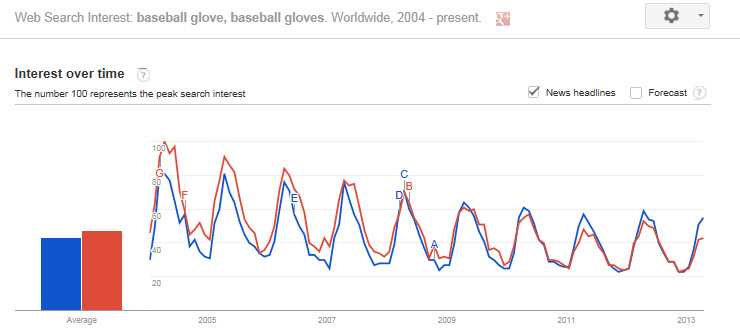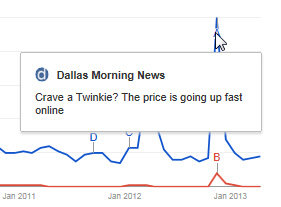Google Trends
 Using Google Trends
Using Google Trends
Keyword Research and Content Marketing
Google Trends allows us to see relative search volume as a function of time. In some cases, the data goes back as far as 2004. As small business owners or managers we all need to realize that we are also marketing managers. Many of you also know that I am a big fan of using the Google Database to conduct market research. It can be invaluable to us.
The Google Database can be an
invaluable marketing tool.
Another aspect of the Google Database that is available to us marketers is the Google Trends database. We all need to keep a watchful eye on the changes and trends in our industry. It’s very important to understand the needs and interests of your target audience(s) and that you respond to large-scale shifts as quickly as possible. This will help you to create that delightful content and have it also timed properly.
By using Google Trends you can spot general trends and changes in search volume that are that are just quick spikes or dips in the search volume for a given keyword phrase. Some trends will be such that you can just ride them out without adjusting your business strategy for other trends you may want to reconsider certain aspects of your business money-making model and make adjustments.
Google Trends is a marketing gem and I strongly recommend that you use it.
Google Trends is a free tool that displays historic search query information, updated hourly, which is sliced and diced in various ways to optimize full scale analytics. It’s most useful to small business owners who are about to embark on a new frontier, or who need to assess how their current offerings are faring in the world of search. With this tool, you can amass data about specific locations, age groups, niches, and related demographic info.
Google Trends gives you the power to study any search term and see how it measures up to other keywords, during specific time periods and/or in specified geographic regions. It’s important to note that you won’t learn how many individuals are searching for your selected keywords, but instead be able to gauge the popularity of a term over time. This is precisely the kind of invaluable insight that can help propel your business to new successful heights.
Types of Google Trends Data
Here is how Google explains Google Trends: “Google Trends analyzes a portion of worldwide Google web searches from all Google domains to compute how many searches have been done for the terms you’ve entered, relative to the total number of searches done on Google over time.”
1) Google Trends and Seasonal Results
Let’s take a B&B business as an example. They may know when there busy time is but do they know when the search volume cycled up that resulted in the higher booking rate?
If you manage a business that sells sports equipment, there will be obvious sales spikes for certain sports items based on the time of year. Google Trends will show you exactly when baseball gloves search volume is trending up and it may be earlier in the year than you imagine.

You can define and manage your marketing campaigns better with this information.
2) Google Trends and Comparing Degree of Interest
Do you need to see how different products compare to each other based on search volume? Google Trends will show you. You can slice this data based on location, keywords, or time of year.
Let’s say you manage an online florist store and need to compare the interest level of roses versus carnations for a given time period, Google Trends can graph search term search volume for each result side by side. Moreover, you can tell if Vermont is more interested in roses than California for any given time period.
This can be competition-beating information in some situations.
3) Google Trends and Forecasting
Sometimes, as marketing managers we want to be able to forecast something. To be able to forecast is a potential business booster. You can tune your inventory to reduce the inventory carrying cost and increase you inventory turns or you ensure that you have enough inventory to reduce delivery time, improve on-time-delivery and accelerate cash flow.
4) Google Trends and Singular vs. Plural Phrases
How about comparing the singular or plural versions of a word? This could matter in a big way and you need to know if this is a factor in your optimization efforts.
If your company sells sports equipment then do you know if people search for “baseball glove” or “baseball gloves”? Google Trends will tell you.

5) Google Trends and Image Search Information
What if you sell a product that people purchase where their judgment criterion is visual? I recently wanted to purchase a new area rug for my office which has recently been done over in a black and white theme. I wanted a black and white area rug and put Google search into image search mode to find rugs that looked attractive to me. My starting point was an image search as opposed to a “web search”.
Google trends can let you know if images are being searched for and if your product is visual in nature then you need to optimize your search engine optimization for images.
6) Google Trends and What’s Hot !?
I once wrote a blog post on Content Marketing and the Hostess Twinkie. I was inspired to do this from a friend that called and asked my how I was coping with the Twinkie Crisis.

I did some up-to-the-minute trend research and concluded that Twinkie was the term to optimize for (not Hostess Twinkie) and that if I could lace the topics of Twinkie and Content Marketing together then I may get a boost in traffic (it was a fun experiment). My traffic for that blog post was 5 times higher than my typical traffic level and spiked just like the Google Trend graph.
These insights are fabulous for media outlets and bloggers looking to report on hot and current topics.
Google Trends – Best Practice
- Use Google Trends to help boost your business through the accurate selection of keyword phrases. Use the tool for extensive studies on which of your targeted keywords are actually used the most, and in what exact format.
- Use Google Trends to gain insights into similar keyword phrases that you may not have considered and get immediate trend analysis.
- Don’t use Google Trends to define your entire keyword strategy. It is a tool (and a good one) but should be combined with other tools.
- You need to analyze the quality of the search popularity, and not just assume high numbers means high interest. Keyword phrases can trend in a negative fashion, due to scandals or current news topics and you may not want to be associated with negative news stories. Make sure that the spikes in popularity you are studying match up with the tone and spirit of your business.
- Google Trends meshes with what is being presented in the news. The letters on the graph trend graphs show a significant news piece on the topic.
- Use the tool to see how well your competitors are trending as well.
- Finally, use Google Trends to help you think of content marketing ideas. If you’re looking for popular current search terms to shape a marketing campaign, or to write compelling content about, Trends is a goldmine.
Content is the single greatest SEO tactic available, so use Trends to help you chart your next great piece of media.
If you want to learn more about Content Marketing then I encourage you to dig in a study our entire series on Content Marketing. Here is a direct link to the Introduction to Content Marketing.
